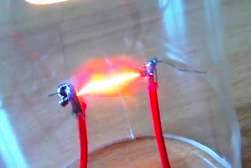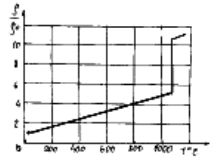Categories: Interesting Facts, Novice electricians
Number of views: 46937
Comments on the article: 0
How does resistance change when heating metals
 The school physics course describes how the resistance of conductors changes when heated - it increases.
The school physics course describes how the resistance of conductors changes when heated - it increases.
The coefficient of relative increase in resistivity during heating for most metals is close to 1/273 = 0.0036 1 / ° С (differences are in the range 0.0030 - 0.0044). And how does the resistance of a metal change during its melting?
Figure 1 shows a graph of the change in the resistivity of copper during heating. As can be seen, at a melting temperature, a jump in resistance of 2.07 times is observed.
Thus, from normal temperature (20 ° С) to the melting temperature, the specific resistance of copper increases by 5.3 times (coefficient K1), during melting it increases by 2.07 times (coefficient K2), and only 10.82 times ( KZ coefficient = K1K2).
Fig. 1. The graph of the change in resistivity of copper during heating.
These coefficients are given for various metals in tablewhere B is the resistance of a kilometer length of wire from a given metal with a cross section of 1 mm2, Tm is the melting temperature of the metal (metals are arranged in order of increasing resistance).
* Due to the special properties of nickel, data are not given (see below).
** Data could not be found.
*** The normal temperature for mercury is the melting point (-39 ° C).
For nickel, resistivity behaves very unusual (Fig. 2). At first it increases, but only to a temperature of 358 ° C, and then decreases sharply and at a temperature above 400 ° C it becomes less than at room temperature.
Fig. 2. Schedule changes in the resistivity of Nickel during heating.
A very unusual metal is bismuth. Its specific resistance during melting decreases sharply, and so that the resistance of the molten metal is lower than that of solid at room temperature.
You can also pay attention to the high value of the coefficient K1 for tungsten. This is why incandescent bulbs have a much lower resistance at the time of switching on than incandescent lamps (in the operating mode (which is why they most often burn out).
Mikheev N.V.
The article was published in the journal "RA-Electric"
See also at bgv.electricianexp.com
:



